Hydroponic cannabis growing guide

Hydroponic cannabis growing is a way of growing cannabis using a solution of just water and nutrients. When using hydroponics, cannabis can grow without soil and typically grows faster than just about any other grow technique. For some people, hydroponic cannabis growing is intimidating, technically demanding and complicated. But others simply wouldn’t grow cannabis any other way. Growing hydroponic cannabis indoors is easy if a few basic rules are followed. Learn everything you should know about hydroponics and whether or not it’s for you.
What is hydroponic grown cannabis?
Hydroponics is a way of growing cannabis without soil. When trying to grow cannabis in a hydroponic system the plants may be grown in a bucket or basket with a full tank/container of nutrients for the roots to grow in.
Hydroponics isn’t an entirely modern invention. Back in 600 BCE, the Hanging Gardens of Babylon were famed for their lush and beautiful growth. The gardens were created by diverting river water into a series of channels in which plants were grown. The Aztecs grew crops on rafts of soil on Lake Tenochtitlan.
The plant roots would dip into the lake water to absorb water. The earliest modern reference to hydroponics was by William Frederick Gericke. While working at the University of California, Berkeley, he began to promote the idea that plants could be grown in a solution of nutrients and water instead of soil. Naturally people disputed his claims, until he proved them all wrong by growing tomato vines 25 feet (7.6m) tall.
Cannabis hydroponic nutrients need to be of the correct blend and strength for the particular growth stage of your plants. The nutrient solution is often fizzing with air bubbles from an air stone or air hose, this prevents the roots rotting in the nutrient solution. Some methods used to grow hydroponic cannabis, such as Nutrient Film Technique (NFT), trickle the nutrients over a fabric mat which the roots grow in/through. This material is exposed to the air, which allows the cannabis roots access to vital oxygen.
There are many variations for a hydroponic cannabis grow. You can buy many different styles of commercial cannabis hydroponic systems. Hydroponic grow kits for cannabis are widely available online or in your local grow shop. Or you can build a homemade hydroponic system for cannabis. But before we get into the technical details, lets take a quick look at the pros and cons of hydroponics cannabis growing.
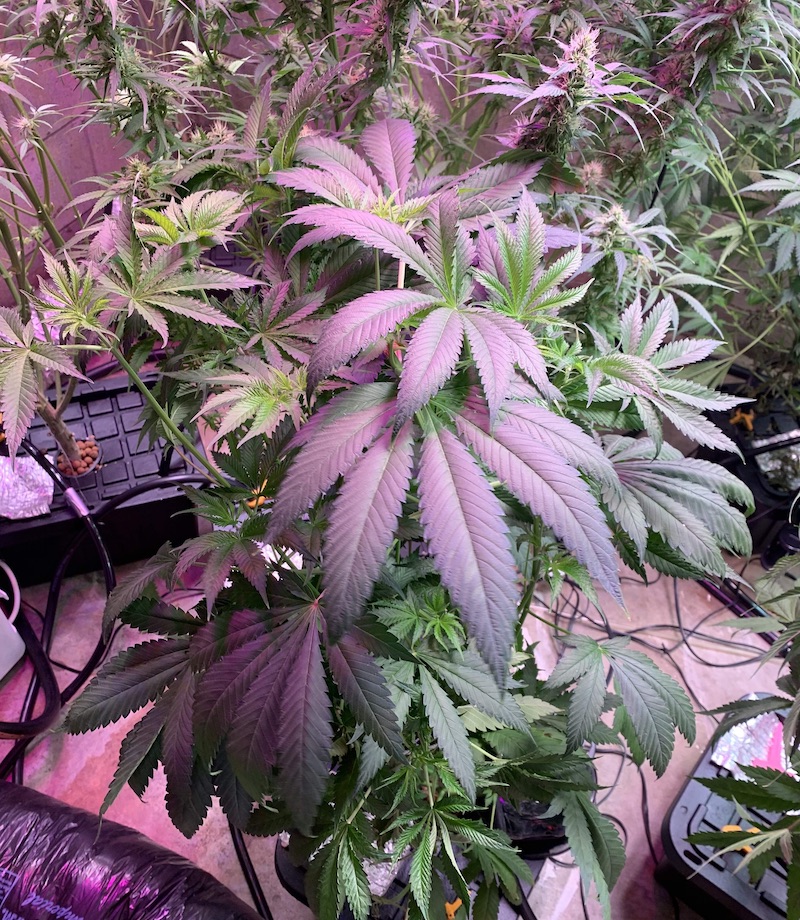
Pros and cons for hydroponic cannabis growing
Many die-hard fans of hydroponic cannabis growing wouldn’t swap to any other grow method. There are plenty of pros to hydroponics. The main benefit being the speed of growth.
Few grow methods would claim to be faster than hydroponics. Hydroponically grown cannabis grows bigger and faster than any other grow method, perhaps 30-50% faster than soil. Other benefits include a cleaner grow room with no soil, or soil-based pests to worry about. With hydroponics, you won’t need to worry about disposing of large quantities of soil or coco fibre after your grow has finished. You may also find your overall water usage levels are lower than they might be for a soil grow since the water is constantly recirculated and re-used.
Perhaps the biggest benefit for the connoisseur hydroponic cannabis grower is the total control they enjoy over various aspects of plant growth compared to other grow methods. Many people think hydroponics is the future for human agricultural food farming.
With hydroponics cannabis growing, the nutrients are dissolved in water. This makes them much more accessible than nutrients locked in soil which the roots must search for. With hydroponics, the cannabis roots are bathed in an aqueous solution rich in oxygen and nutrients. It’s the perfect recipe for rapid growth.
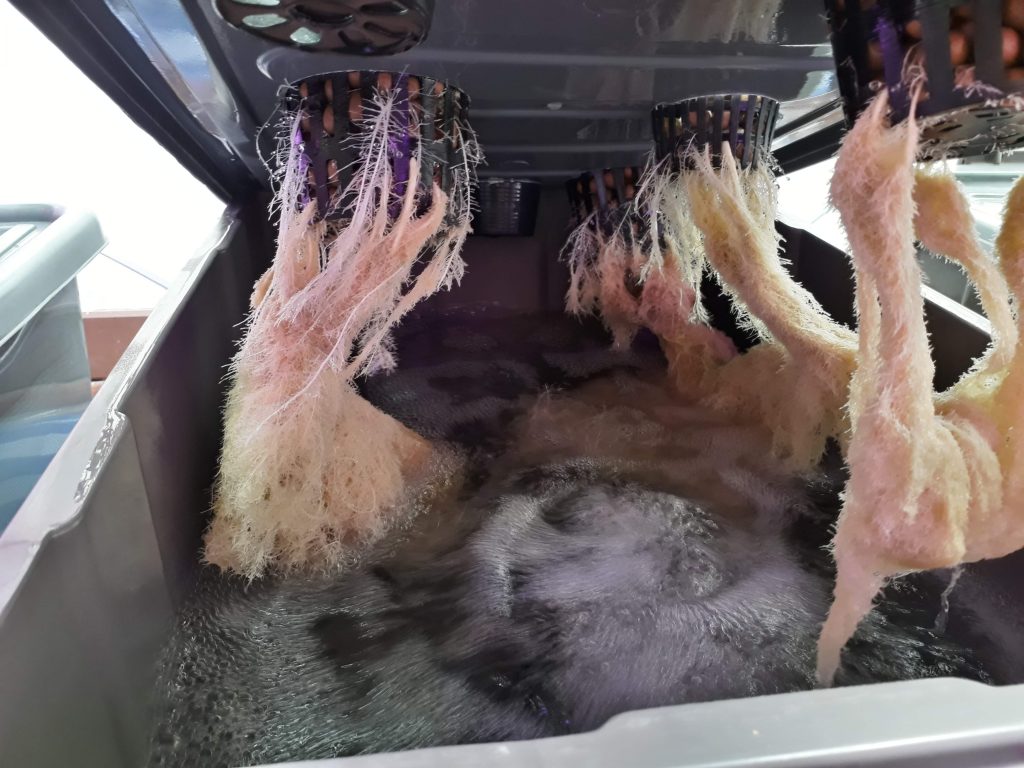
However, there is a technical price to pay for such growth benefits. As well as knowing the best nutrients for hydroponic cannabis you also need a precise touch with nutrient application. Knowing how to keep your plants in the nutrient sweet spot throughout the hydroponics grow is critical to success.
Avoiding over/under feeding and matching nutrient feeds with your plant requirements at every stage of growth is essential. That’s one reason why hydroponics is often avoided by rookie growers. Books on hydroponic cannabis growing can be a great help. But in general, one of the cons of hydroponic cannabis growing is the technical complexity. This deters a lot of growers until they have grasped the basics of general cultivation experience.
Controlling the hydroponic nutrient solution is important. You will need to know, use and understand pH and EC meters. You will also have to calibrate them regularly and have spares just in case one of your meters starts to deliver inaccurate readings. Remember, with hydroponics, if you set pH or EC incorrectly you can damage the entire crop irreversibly and very quickly.
Some growers dislike the extra equipment required for hydroponic cannabis growing. Compared to a simple soil grow, you will need a (potentially noisy) air pump and a hydroponic system which may have a water pump, a water heater (or chiller), extra timers etc. The best hydroponic systems for cannabis can indeed produce explosive growth when used correctly. But get the conditions/nutrients wrong and you can devastate your crop with equal speed.
How to build your own DIY hydroponic system
If you are new to hydroponic cannabis growing then it may be far simpler to buy an off-the-shelf system. You will have several different options to choose from and all of them should work well.
If you are perhaps more experienced with hydroponics you may want to think about trying to build a simple hydroponic system for cannabis. A hydroponic cannabis set up will require a basic shopping list of components.
Some of the most important components of the grow are shown below. When building a system to grow hydroponic cannabis, costs may be high but these are usually repaid after the first harvest is complete
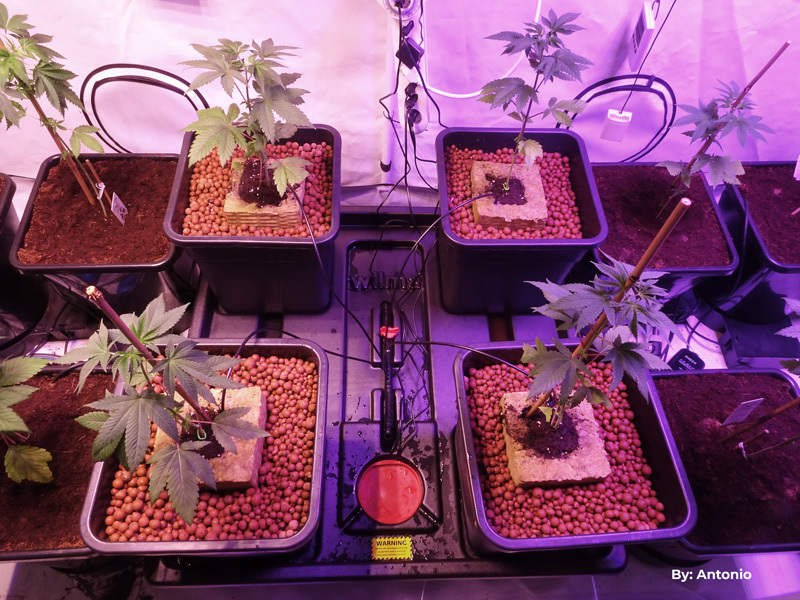
Equipment needed for a hydroponic grow
The more experienced the grower, the easier and less daunting it will seem to create a homemade hydroponic system for cannabis. Here are the basics:
- Grow room lighting with hanging equipment
- A grow tent or grow room
- A hydroponic reservoir and maybe a tray to grow on (for NFT growers)
- An air pump with an air-stone or air-tubes. Note the more experienced growers tend to prefer particularly powerful pumps to generate real ‘fizz’ in the nutrient solution
- A growing medium, eg coco fibre if growing with a drip system
- Net pots. Mesh plant pots are perfect for e.g. DWC (deep water culture) hydroponic growing
- Some hydroponic cannabis seeds. Later on we will recommend our preferred strains.
- A carbon filter to remove odours from the used grow room air
- A clip-on fan to circulate grow room air
- An extraction fan to remove old grow room air, with tubing
- Nutrients
- pH and EC meters. EC meters measure electrical conductivity of your nutrient solution, it’s a way of understanding the nutrient/mineral content of the water
- A moisture meter (hygrometer), useful for monitoring relative humidity and ensuring it doesn’t get too high near harvest (risk of mold/bud rot)
- A de-humidifier to ensure humidity is kept at the right levels during the grow. It’s particularly important to prevent humidity climbing too high in late bloom or you could see mould. If you live in a very dry climate then you may have the opposite issue and need to buy a humidifier.
Of course professional hydroponic cannabis growers would add other specialist equipment, such as UVB-UVA lights (to boost cannabinoid content) and perhaps CO2 supplementation to really push yields to the limit.
Average cost of growing with hydroponics
It may cost you around €/$/£ 200-300 to build a basic hydroponic cannabis grow system. But once your investment is made you should find that ongoing running costs are similar to other grow methods. The main ongoing costs will be electricity, nutrients and cannabis seeds. These costs are common to all grow methods. However, with hydroponics you may be saving on the costs of soil or coco fibre grow mediums.
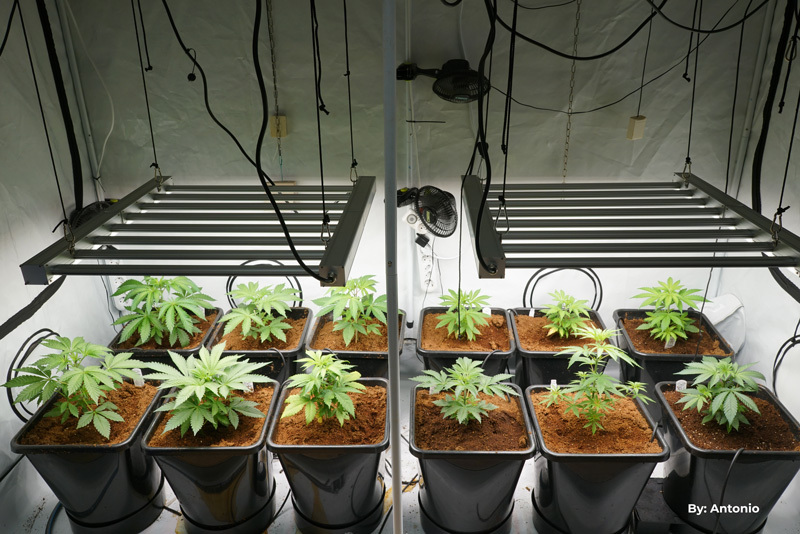
Choosing the right grow medium
In hydroponics a grow medium gives a solid foundation to hold the plant upright. There are several common materials which can be used. Here are 4 of the most frequently used.
Rock wool
Sometimes this is called glass wool or mineral wool. It’s made by spinning (or drawing) molten minerals/rocks into a candy-floss texture. It is used for heat insulation, noise insulation and of course hydroponic cannabis growing. Rock wool holds large amounts of water as well as allowing good levels of oxygen penetration. Perfect for cannabis roots! Rock wool is often supplied in various sized cubes designed to fit directly into e.g. NFT hydroponic systems. Many DWC growers also use rock wool cubes in the plastic mesh plant holders.
Perlite
Perlite is a porous mineral material made from expanded volcanic glass. Because it’s porous, it holds water and oxygen well. Vermiculite is a similar material which is also widely used.
Coco fibre
Sometimes known as coco coir, this is made from the husk of a coconut. It’s a great grow medium, offering good water holding properties as well as excellent root aeration levels. Coconut fibres are also thought to protect cannabis roots from infection thanks to the presence of plant-stimulating hormones.
Clay pebbles
When considering how to grow hydroponic cannabis, many find that clay pebbles offer a convenient base for your plant, especially when using mesh/net containers that are popular in deep water culture (DWC) hydroponics. Many growers soak their clay pebbles in pH adjusted water around pH 5.6 for a few days. This can counter the natural tendency for some clay pebbles to cause pH to drift up towards pH6.
Cannabis roots grow around the clay pebbles, absorbing nutrient solution as well as atmospheric oxygen. In e.g. a DWC system, the roots eventually reach down into the bucket of nutrients. Until the roots have grow long enough to reach down through the mesh holes to the nutrients, the small plant is often watered from above.
In ebb and flow or dripper hydroponic systems, many people use clay pebbles as their main grow medium.
| Related: |
| How to choose the best soil for cannabis |
Indoor vs outdoor hydroponic growing
Hydroponics is mainly used indoors, where growers can control all environmental parameters with precision. But some growers also run hydroponic systems in greenhouses or outdoors.
Outdoor hydroponics is possible, it means you can use the sun instead of a grow light reducing grow costs. But controlling nutrient solution temperature around the desired 20ºC/68ºF is usually a challenge.
Outdoor hydroponics is being increasingly explored by food farmers, where it holds possibilities to grow crops in areas with desert/sandy terrain unsuitable for growing traditional fruit and vegetables.
| Related: |
| Autoflower vs feminised outdoor cannabis growing |
Best hydroponic cannabis setup
When people first started to study hydroponic vs soil cannabis, it was clear that hydroponics offered some significant advantages in the speed of growth. Over the years, many different types of hydroponic systems have evolved. They all share the same basic principle of bathing the cannabis roots in an oxygen rich environment alongside nutrients dissolved in water. Here are some of the most popular types of hydroponic system.
Aeroponics
This high-tech hydroponics system creates a fine mist of nutrient solution around the root zone of the plant. Growth rates are very high with roots supplied with both oxygen and nutrients. Aeroponic is regarded as a technically demanding even by experienced hydroponic cannabis growers.
Wick system hydroponics
This simple hydroponic system uses a wick dipped in the nutrient solution. The wick draws up nutrient rich liquid to the net/mesh root container where it feeds the roots. This is a passive feed system without a pump.
Nutrient film technique
Sometimes known as NFT hydroponic cannabis growing, this is one of the more popular systems with home growers. NFT uses gravity to flow the nutrient solution down a carrier mat. The cannabis roots grow down from the plants above which are often in a rock wool cube. Once the roots hit the carrier mat they grow along it, absorbing all the oxygen and nutrients they need. A pump recycles the nutrient solution.
The principle of NFT is not too dissimilar to that of plants growing on rocky river banks, with the roots delicately dipped in the water. The nutrient reservoir may often contain an air stone to oxygenate the water and perhaps a heater to ensure the water temperature is maintained. In hot climates, hydroponic growers have chillers to stop the nutrient solution getting too warm.
Drip/dripper hydroponics
The principle of a hydroponics dripper system is broadly similar to that of a drip irrigation system in soil. The cannabis plant is often grown in a medium such as clay pebbles. At the top of the plant is a small tube (or ring-shaped tube) which drips nutrients onto the surface.

Ebb and flow
Also known as flood and drain, this type of hydroponics completely submerses the cannabis roots and grow medium in nutrient solution for perhaps 5-15 minutes or so every few hours. The regularity of the flood and drain is determined by ambient temperature, grow medium, plant size and nutritional needs.
With expanded clay pebbles: flood and drain 4 to 8 times a day (every 2 to 4 hours)
With coconut coir: 3 to 5 times a day (every 3 to 5 hours)
With rockwool: 1 to 5 times a day (once a day to every 3-4 hours)
Once the roots/medium have been flooded with nutrient solution it is pumped back into the reservoir where it is kept oxygenated with an air stone.
Please note that these are only guidelines. Feel free to use different flood and drain schedules to meet your specific needs. Many suppliers of hydroponic equipment will give detailed flood and drain recommendations.
If you are growing very large plants in a hot/dry climate with powerful lights and a long lights-on period (‘day time’) of e.g. 18 hours then you may well need to flood and drain 10 or even 15 times per day.
You may also need 1-2 floods per night if you are in bloom (therefore you have 12 hour darkness periods) or during a warm summer. Also please note that a ‘day’ refers to the ~18 hours when lights are on. If you are doing flood and drain outdoors, the ‘day’ refers to the period when the sun is shining. If the night period is just 6 hours or so you may not need to flood.
In general, flood times don’t need to be much more than 10 minutes. If you are using clay pebbles you may be able to take 1-5 minutes off that flood time. Water retention of your grow medium makes all the difference here. Eventually, you may find that you have the experience to fine tune your flood schedule at various stages of plant growth. Young, smaller plants need less water than fully mature plants. Many growers start with less frequent floods and shorter flood times and gradually increase as the plants mature
Deep water culture
DWC is a popular form of hydroponic cannabis growing. The plant is held in a plastic mesh pot, often in clay pebbles or rock wool, over a large nutrient bucket. This is often around 25 litres and contains an air stone. Very fast growth rates and amazingly high yields are seen.

| Related: |
| SOG vs SCROG techniques compared |
Hydroponic setup maintenance tips
Hydroponic cannabis growing offers the fastest rates of growth. Unfortunately it can also offer rapid problems if your plant and system maintenance is not up to the mark. Here are some expert tips on things you need to monitor closely.
pH level
pH is a measure of nutrient solution acidity/alkalinity. The normal ph level for hydroponic cannabis is around 5.6-5.8. Outside of this pH range your plant may not be able to absorb minerals/nutrients even if they are present. This is known as ‘pH lockout’ and is a key reason why hydroponic cannabis growing needs a steady pH around 5.6 – 5.8.
Temperature
Maintaining nutrient solution temperatures of around 20ºC is felt to be optimum in hydroponic cannabis growing. For many growers in winter this can mean adding a water heater to your nutrient reservoir. Conversely, in hot summer months, it can be mandatory to use a chiller to stop your nutrient solution getting too warm. As well as being bad for your plants, hot nutrients can encourage undesired bacterial growth.
Cleanliness and housekeeping
The best hydroponic cannabis growers are meticulous about cleanliness in their grow system and grow room. In addition to cleanliness, your nutrient solutions require reasonably regular changes, perhaps weekly with top ups of half strength or quarter strength nutrients to maintain levels in between. As well as regular nutrient changes, the tanks should be thoroughly cleaned with each nutrient change.
Maintain the nutrient sweet spot from seed to harvest
Without doubt, one of the main skills of a successful hydroponics cannabis grower is the ability to avoid over-feeding and under-feeding their plants. Keeping the right nutrient regime at all stages of plant life is the best way to grow large and healthy cannabis plants. Few cannabis growers discover that they have great nutrient management skills on their first grow. Usually this skill is developed over several grows, often with simpler grow systems like soil or coco fibre growing.
How to grow cannabis with hydroponics
With so many different variations of hydroponic grow systems it is important for each grower to get to know their own system inside out. You may need to make subtle differences in your grow style when you switch from one hydroponics system to another.
Hydroponic cannabis growing schedule
Your hydroponics grow schedule may seem a little busier than usual, especially if you were used to growing in large containers of soil. A schedule of regular nutrient bath changes will be a routine task.
Nutrient solutions are often made up the day before and allowed to rest overnight, allowing gases such as dissolved chlorine (from water treatment plants) to disappear. The old nutrients are disposed of, tanks and pipework cleaned and new nutrients are added.
How and where to germinate your seeds
For the best germination rates, Dutch Passion recommend that you use the following cotton pad cannabis seed germination method.
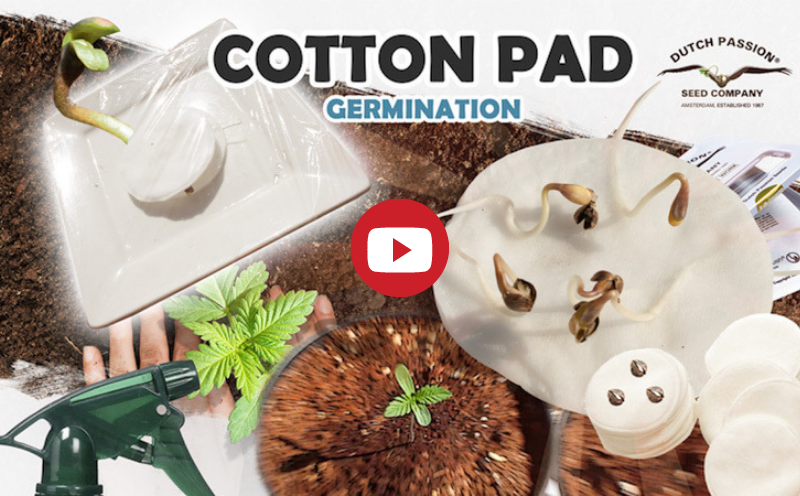
Nutrient feeding program
All the leading cannabis nutrient companies supply good quality nutrients which will work well in hydroponics. Many growers have their preferred nutrient brand and can be reluctant to change, especially when they have lots of experience with one particular brand.
Part of the skill of the best hydroponics growers is nutrient management. The more experienced growers understand the plants nutritional needs at each stage of growth and can adapt and control the nutrients accordingly. Using the manufacturers grow guides is a useful starting point.
In general, nutrient concentrations should be slowly increased throughout the grow. If in doubt, err on the side of caution. It is better to slightly underfeed a plant than to burn her with excessively strong nutrients which may permanently stunt future growth. Many growers make up a fresh bath of nutrients around once per week. In late bloom, when plants can use up to 5 litres of nutrients/water per day, some hydroponic cannabis growers will perform more frequent nutrient bath changes.
| Related: |
| A visual guide to cannabis deficiencies |
Monitoring pH levels
Nutrient pH should be monitored and maintained in the preferred range of around 5.6 – 5.8. Remember, outside of this pH range nutrients may be present but not bio-available to the cannabis roots (nutrient lockout). One of the downsides of hydroponics is this reliance on a tightly controlled pH. That’s why you need to regularly calibrate your pH (and EC) meter. Eventually all pH meters will fail and start to deliver false readings. That’s why the professional growers always have a spare pH meter.
Providing your plants with sufficient light
Just as with any other grow method, hydroponics requires you to provide top quality lighting for the best results, the healthiest plants, the heaviest yields and the most potent buds. If you are going to the trouble of using a technically challenging grow method such as hydroponics you may also wish to opt for the best lighting you can afford.
In general, LED grow lights are regarded as superior to HPS with a better light spectrum, less heat stress, longer lifetime and more efficient energy use. The only downside to LED is the initial upfront purchase cost. Though that is mitigated by the fact that they could last 10-15 years or more without any significant loss of light output.
| Related: |
| The beginner’s guide to growing weed indoors |
Controlling the water temperature
Keeping the water/nutrients cool is best for your plants. A temperature of around 20ºC/68ºF is regarded as ideal for the cannabis roots to absorb the nutrients. If the temperature is too cold then growth is slowed. Too hot and the roots will struggle to remain healthy and you may also see bacterial/fungal growth in your nutrients.
Preventing humidity peaks
Hydroponic cannabis growing can produce huge buds. This is a great reward for the hard working grower. But it can also present a risk of mold/bud rot if relative humidity is allowed to get too high during late bloom. A good way to monitor this is with a humidity meter. If humidity levels are much above 50% it could be an idea to invest in a dehumidifier for your grow room.
Hydroponic cannabis FAQ
Over many years supplying cannabis seeds to growers we have received many questions about hydroponics. Here are some of the most frequently asked questions:
How to stop root rot in hydroponic cannabis plants?
Maintaining a fresh bath of nutrients at the right pH and temperature is the best way to prevent root rot. Some growers add silver-containing additives to their nutrients which have an anti-bacterial effect and minimise the chances of root rot. If ever you notice a bad smell from your nutrients it is an indication that bacteria are established and new nutrients are definitely required.
What about hydroponic cannabis damping off?
Damping off is a seedling disease caused by several different pathogens. These cause the stem to shrivel and the seedling to eventually collapse. Good cleanliness standards are essential, ensure equipment is thoroughly cleaned between grows. Don’t overwater and ensure good ventilation.
What is the best hydroponic cannabis growing schedule?
Much depends on the age, size and strain of your cannabis plants. The skilled hydroponics cannabis grower has a well developed understanding of all aspects of plant growth, nutrient schedules, nutrient bath changes, housekeeping cleaning etc. Usually prospective hydroponic growers spend a grow or two with a simpler grow method (e.g. soil) just to familiarise themselves with the basics of plant growth and nutrition before attempting to create a hydroponic cannabis growing schedule.
Can cannabis plants last 12 hours with no floods/water in a 12/12 light schedule?
During the night time the plants are less active and usually don’t need flooding. However, when you are in a flowering stage with a 12/12 light cycle it is recommended to flood the plants at least once per night. Preferably somewhere in the middle of the night so the plants only have to go a maximum of 6-8 hours without any moisture. The downside of flooding during the night is a humidity spike in the room. Therefore, it would be best to use a de-humidifier simultaneously to keep the humidity under control.
What is the ideal humidity level for hydroponic cannabis?
High humidity levels are useful especially for seedlings and cuttings with incomplete root systems and during vegetative growth. But as the plant develops a healthy root system and approaches harvest it is good practice to keep humidity below 50% and nearer 40%. This minimises the chances of mold or bud rot causing any damage.
How to prune hydroponic cannabis?
It’s up to you! Normal rules apply. If you want to produce a short, bushy plant with lots of side growth then you may wish to remove the growing tip of your plant. This is sometimes called topping or fimming your plant. It’s a good way to modify plant growth if e.g. you have a small grow room and a tall, stretchy strain. A SCROG could be very useful to control the height and massive growth of your hydroponically grown cannabis plants.
Is outdoor hydroponic cannabis growing popular?
Some growers find outdoor hydroponics is a good way to grow but it does come with some serious additional challenges over indoor growing. For example, controlling nutrient temperature is tricky outdoors if it is mid summer. Most hydroponic cannabis growers tend to be indoor growers.
When should you start cropping hydroponic cannabis plants?
Just look for the usual signs that your cannabis plant is nearing harvest. You may wish to examine the trichomes and assess how many are clear, cloudy or amber. You may also look at the general bud/leaf appearance to see how near the plant is to harvest, as well as look at the pistils (hairs which come from the buds) to see if the plant is still pushing out white pistils or if they are turning increasingly red/orange. Personal preference plays a large part in determining the harvest point.
How much hydrogen peroxide hydroponics cannabis safe per gallon in hydroponics?
Hydrogen peroxide is often added to nutrient solutions in hydroponic grow systems. It adds extra oxygen to the water and it can prevent bacterial build up. The recommended amount of 3% solution of peroxide per gallon of water in hydroponics is around 3ml per litre or 2-3 teaspoons (10-15ml) per gallon.
How many feet apart should cannabis plants be on an indoor hydroponic unit?
If you are growing lots of small plants in a SOG system you can pack in many times more plants than if you were cultivating a single large SCROG plant. If you are growing plants naturally, without SOG or SCROG then around 8 inches separation is not uncommon. The more space you give each plant, the easier it is to work with your plants and inspect them.
Plant spacing is also dictated by the type of system you use. A DWC system with 25 litre pots could easily fill a room with 4-8 large bushy plants. On a flood and drain (or aeroponics) system you may prefer to switch to a more SOG style grow with around 12-16 plants per m2.
How many times should you water hydroponic cannabis?
Your plant roots are bathed in nutrient solution so you shouldn’t need to water them manually. All you may need to do is maintain reservoir volumes by topping up with e.g. quarter strength nutrients. Topping up with diluted nutrients counters the natural tendency of evaporation which tends to gradually concentrate minerals/nutrients in the nutrient bath.
What size hydroponic containers are best for cannabis?
This depends on your hydroponic grow system. A DWC bucket may be 25 litres or more for just a single plant. Or you can buy an NFT system with space for 8 plants which may use just a small rock wool cube as the base for each plant and a 25-50 litre reservoir for all 8 plants.
When to transplant hydroponic cannabis?
For those who grow hydroponic cannabis using rock wool cubes (e.g with NFT hydroponics) it is easy to insert a small rock wool cube inside a larger one. If your hydroponics cannabis grow is done in a DWC system, then you may simply place your seedling in a rock wool cube (or coir cube) in the plastic mesh container and surround it with a few supportive clay pebbles. Once the seedling is in it’s final hydroponic position, leave the genetics to do the rest of the work and focus your efforts on maintaining optimised environmental conditions.
Why is there a taste difference between hydroponic and soil grown cannabis?
Some soil growers will claim that an organic soil grow delivers a somewhat deeper and richer taste than hydroponic cannabis. This can be a subjective viewpoint, since lots of hydroponic cannabis growers would argue that their buds are just as flavoursome as any soil grow.
However, growing traditional foodstuffs in different types of soil does affect taste. So there may well be subtle differences between the best hydroponic cannabis and the best soil grown cannabis. But which grow method tastes better? That could be a long debate between growers.
Some nutrients are thought to be particularly effective in their ability to increase flavor and smell, Dyna-Gro hydroponic cannabis nutrients are one brand that have a good reputation for this.
Cannabis hydroponics, how long does it take to grow?
Much depends on the cannabis seeds you are growing. If you are growing autoflower seeds in a hydroponic cannabis grow then you may be ready to harvest in as little as 8-9 weeks for super fast autoflower seeds. Conversely, if you’re growing a slow blooming haze then your total grow cycle could be around 20 weeks (6 weeks veg + 14 weeks bloom).
How to start hydroponic cannabis seeds?
Once you have selected the best cannabis seeds for your hydroponic cannabis grow they need to be germinated in the normal way. Dutch Passion strongly recommend germinating your cannabis seeds between a couple of lightly moistened (but never soaked) cotton pads. Some hydroponic cannabis growers prefer to germinate their cannabis seeds in a rock wool (or coco coir) cube which may be more convenient for their hydroponic system.
Best cannabis seeds for hydroponics
Any of the Dutch Passion cannabis seeds will perform well in hydroponic cannabis grow. Remember you can expect far faster growth than other grow methods so you may want to avoid the stretchiest tent-filling Sativa/Haze cannabis seeds unless you have ample grow space.
Growers that specialise in hydroponic cannabis often have their own preferred strains. These may have been selected purely for their combination of high THC and heavy yields. Or they may be preferred because they are particularly fast to reach harvest or because they have a rare and rich taste/aroma.
Whether you prefer an Afghani Kush, a USA special strain, a CBD rich strain or a skunk you have plenty of good quality cannabis seed options. Remember the cost of your cannabis seeds are a low part of your overall grow costs, so choose your seeds wisely and aim for the best quality weed seeds you can buy. Here are some of the best cannabis seeds for your next hydro grow
Kerosene Krash
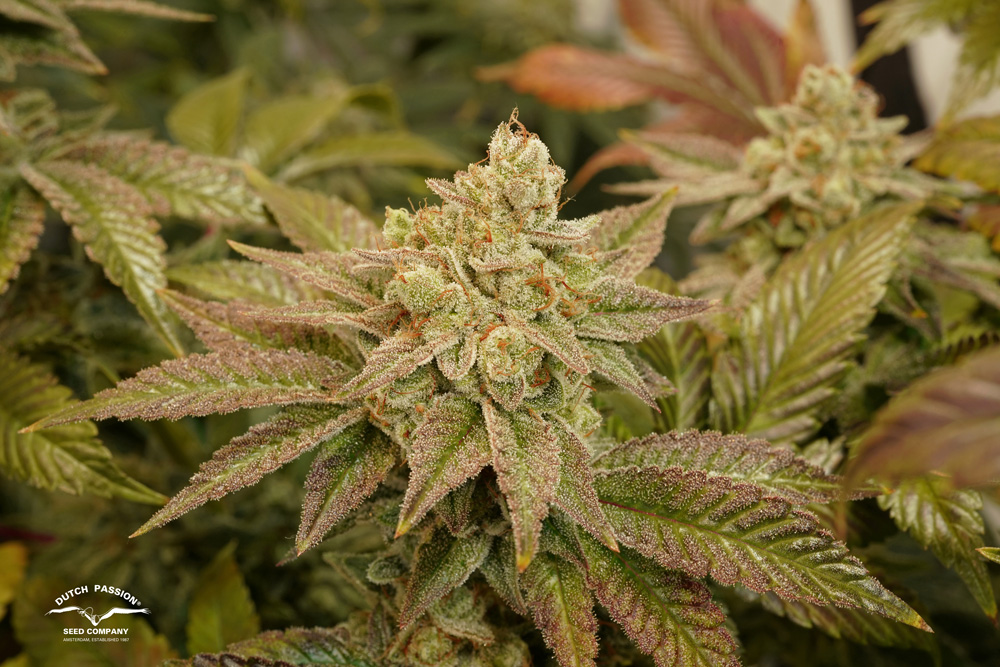
Kerosene Krash feminised seeds use multi cannabis-cup winning USA genetics from Sherbet and Gorilla Glue #4 in a superb indica which takes around 8 weeks to bloom. THC levels are sky high, expect THC levels up to around 20% (maximum 25%). Maybe a little higher in a fully optimised grow room with good LED lights and perhaps some UVB supplementation.
You will be guaranteed Grade-A buds in generous quantities. But the most acclaimed quality from these USA Special genetics isn’t the THC level, it’s the unsurpassed terpene profile which delivers one of the best taste/aromas that the Dutch Passion team have ever experienced. It’s a delicious and highly penetrating fruity Kush aroma with a huge splash of diesel/fuel and some pungent earthy scents. Incredible quality buds with a quick bloom time and a superbly enjoyable high. Perfect for your next hydroponic cannabis grow!
Related:
Kerosene Krash grow review in a 25 litre Autopot of coco fibre under LED grow lights
Auto Cinderella Jack
Auto Cinderella Jack is an autoflowering cannabis seed variety. She grows well indoors under a 20 hour daily light cycle and take around 11 weeks to grow from seed to harvest. Auto Cinderella Jack has the highest THC levels ever seen on a Dutch Passion autoflower. In fact, with confirmed THC levels of 25.9%, Auto Cinderella Jack has the highest THC levels ever seen by Dutch Passion on any autoflower – even from other seed banks!
Related:
With THC levels over 25%, is Auto Cinderella Jack the world’s strongest autoflower?
If you’re looking to grow hydroponic cannabis with the highest THC levels in the shortest amount of time, Auto Cinderella Jack seeds are a perfect choice. These sensational autoflower genetics deliver genuine XXL yields combined with best-ever potency levels.
Sugar Bomb Punch
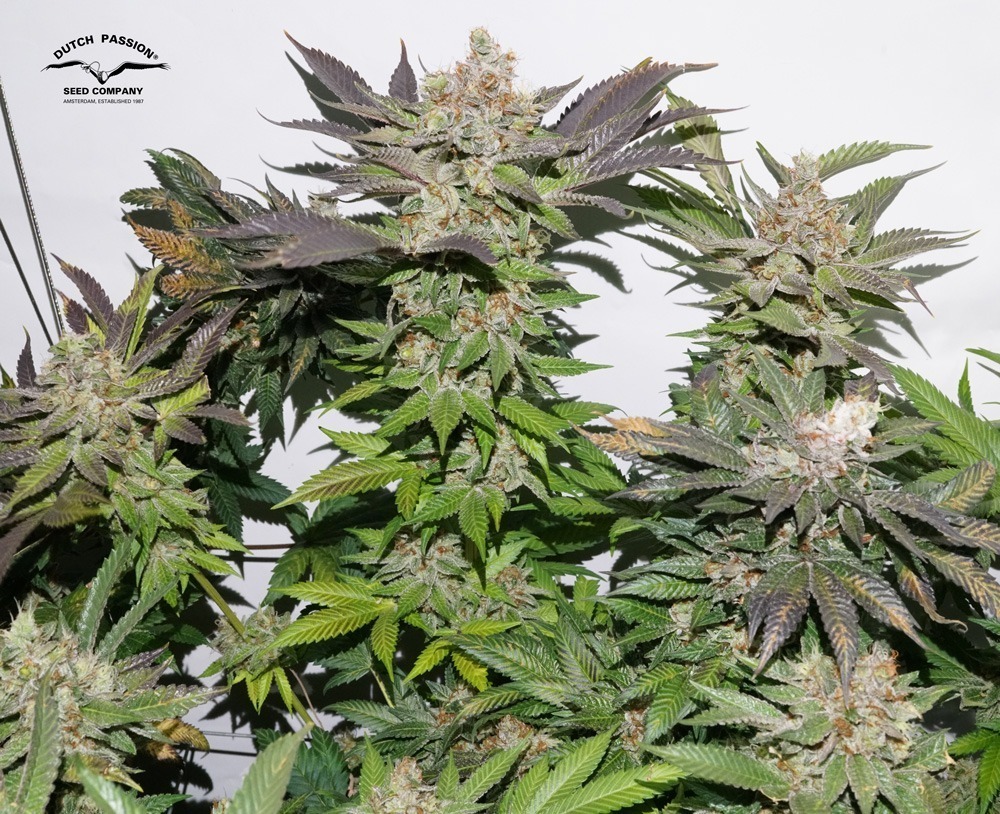
Sugar Bomb Punch is a USA Special strain with extremely high THC levels. Expect THC anywhere up to 25% on this indica strain. The Dutch Passion team rarely see feminised photoperiod genetics get much stronger with such heavy yields. It is the ideal strain for hydroponic cannabis growers seeking the stickiest buds and highest THC levels. The genetics used to create this variety guarantee the following properties:
- A plant completely covered in with glittering white super-sticky buds.
- A complex aroma and a potent cannabinoid profile with high THC levels.
- Compact plants and buds that are easy to harvest thanks to the good flower-to-leaf ratio.
Related:
Sugar Bomb Punch grow review, grown under LED grow lights in a SCROG with 25 Litre autopots
Amsterdam Amnesia

No hydroponic cannabis seed recommendation would be complete with giving due consideration to a top quality Amnesia. With the incredible Amnesia high, rapid growth, distinctive aroma and hard sticky buds Amnesia is a firm favourite with many hydroponic cannabis growers for all the right reasons.
Amsterdam Amnesia is Dutch Passion’s very high THC Amnesia. It uses the finest Amnesia genetics ever seen by the Dutch Passion team. These sativa genetics take around 9-10 weeks in bloom with heavy yields and very sticky, resin covered buds. Amsterdam Amnesia is a perfect choice for any grower seeking a guaranteed top quality crop of genuine Amnesia genetics with a knockout high.
Conclusion, hydroponic cannabis growing can be difficult to beat!
Many of those that have taken the leap into hydroponic cannabis growing simply never look back. The ability to grow larger plants, enjoy increased yields and shave a few days off the grow cycle are all highly desirable benefits. Especially for commercial hydroponic cannabis growers.
If you have already grasped the basics of cannabis cultivation then making the transition to grow hydroponic cannabis shouldn’t worry you. Our best advice to anyone thinking about hydroponic cannabis growing is to assess a few different systems and find one which best suits your situation, skills, space and time.
We would also recommend growers take extra care and attention with their daily plant maintenance when upgrading to hydroponics. The accuracy of your pH and EC readings is crucial, calibrate your meters regularly and have spare replacements for the inevitable day when your meters fail.
But once you are settled into a routine, a hydroponics cannabis grow offers a hugely enjoyable grow experience as well as unsurpassed speed and growth of your plants.


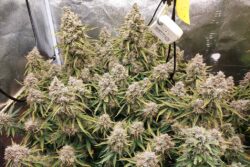















3 Comments. Leave new
why so noisy how can the clunking sound and noise from the air pump be reduced
I think this is mostly dependent on the pump you are using. You can check out this forum which gives some answers to your question: http://www.uk420.com/boards/index.php?/topic/392346-what-is-the-most-silent-air-pump-out-there/
Greetings,
Joe
Dutch Passion
Thank you very very much!!!
For your very enjoyable and informational advice, I’m very excited to get started being a
Mad scientist in DWC cannabis
Growing, have in the past had
Awesome growing experience
Outdoors, but natural pests, bad
dirt, NOISY PEOPLE, I’m going inside!!! Where one can feel safe and free, I have a lot of questions,#1 how does one get seeds all the way across the Atlantic ocean to the US without problems from the customs agency ,? #2 how to pay for your product? Would this be a safe endeavor for me?
I have a very acute Disdain for
Problems,! Very private person!!!